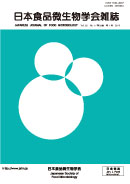Volume 32, Issue 1
Displaying 1-11 of 11 articles from this issue
- |<
- <
- 1
- >
- >|
Reviews
-
Article type: Review
2015 Volume 32 Issue 1 Pages 1-11
Published: March 31, 2015
Released on J-STAGE: September 10, 2015
Download PDF (415K) -
Article type: Review
2015 Volume 32 Issue 1 Pages 12-16
Published: March 31, 2015
Released on J-STAGE: September 10, 2015
Download PDF (1216K)
Educational Lecture
-
Article type: Educational Lecture
2015 Volume 32 Issue 1 Pages 17-27
Published: March 31, 2015
Released on J-STAGE: September 10, 2015
Download PDF (544K)
Symposium II: Food Expiration Dates and Quality Assurance
-
Article type: Symposium II: Food expiration dates and quality assurance
2015 Volume 32 Issue 1 Pages 28
Published: March 31, 2015
Released on J-STAGE: September 10, 2015
Download PDF (144K) -
Article type: Symposium II: Food expiration dates and quality assurance
2015 Volume 32 Issue 1 Pages 29-33
Published: March 31, 2015
Released on J-STAGE: September 10, 2015
Download PDF (264K) -
Article type: Symposium II: Food expiration dates and quality assurance
2015 Volume 32 Issue 1 Pages 34-35
Published: March 31, 2015
Released on J-STAGE: September 10, 2015
Download PDF (270K) -
Article type: Symposium II: Food expiration dates and quality assurance
2015 Volume 32 Issue 1 Pages 36-39
Published: March 31, 2015
Released on J-STAGE: September 10, 2015
Download PDF (652K) -
Article type: Symposium II: Food expiration dates and quality assurance
2015 Volume 32 Issue 1 Pages 40-47
Published: March 31, 2015
Released on J-STAGE: September 10, 2015
Download PDF (582K)
Originals
-
Article type: Original
2015 Volume 32 Issue 1 Pages 48-53
Published: March 31, 2015
Released on J-STAGE: September 10, 2015
Download PDF (361K) -
Article type: Original
2015 Volume 32 Issue 1 Pages 54-59
Published: March 31, 2015
Released on J-STAGE: September 10, 2015
Download PDF (300K)
Method
-
Article type: Method
2015 Volume 32 Issue 1 Pages 60-66
Published: March 31, 2015
Released on J-STAGE: September 10, 2015
Download PDF (286K)
- |<
- <
- 1
- >
- >|
